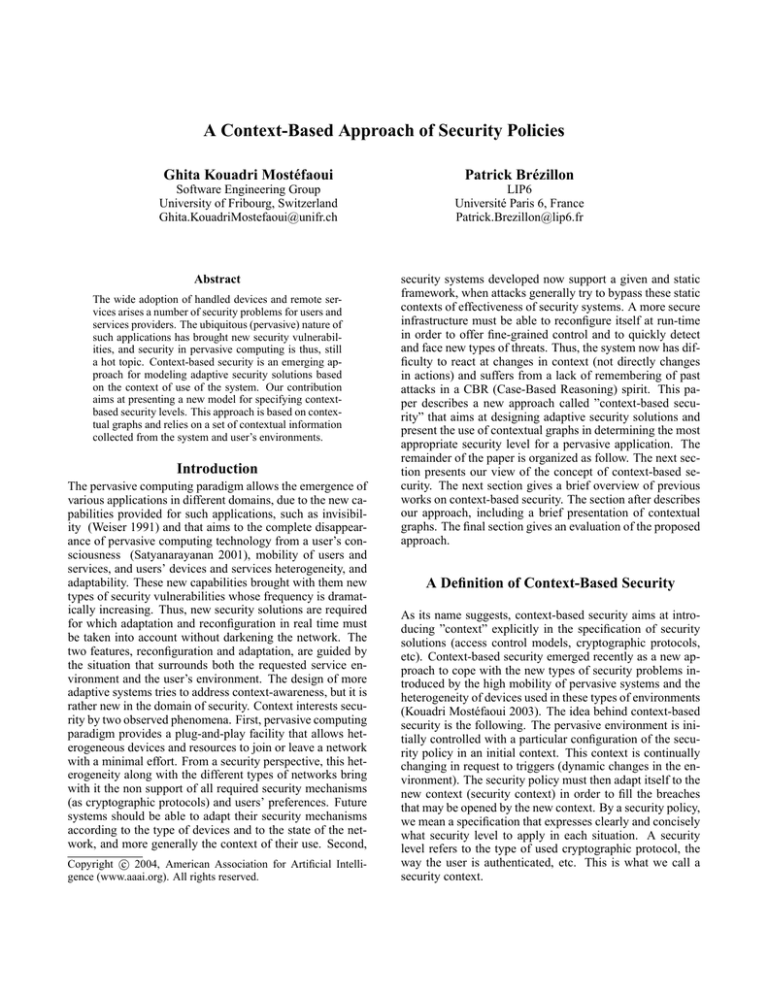
A Context-Based Approach of Security Policies
Ghita Kouadri Mostéfaoui
Patrick Brézillon
Software Engineering Group
University of Fribourg, Switzerland
Ghita.KouadriMostefaoui@unifr.ch
LIP6
Université Paris 6, France
Patrick.Brezillon@lip6.fr
Abstract
The wide adoption of handled devices and remote services arises a number of security problems for users and
services providers. The ubiquitous (pervasive) nature of
such applications has brought new security vulnerabilities, and security in pervasive computing is thus, still
a hot topic. Context-based security is an emerging approach for modeling adaptive security solutions based
on the context of use of the system. Our contribution
aims at presenting a new model for specifying contextbased security levels. This approach is based on contextual graphs and relies on a set of contextual information
collected from the system and user’s environments.
Introduction
The pervasive computing paradigm allows the emergence of
various applications in different domains, due to the new capabilities provided for such applications, such as invisibility (Weiser 1991) and that aims to the complete disappearance of pervasive computing technology from a user’s consciousness (Satyanarayanan 2001), mobility of users and
services, and users’ devices and services heterogeneity, and
adaptability. These new capabilities brought with them new
types of security vulnerabilities whose frequency is dramatically increasing. Thus, new security solutions are required
for which adaptation and reconfiguration in real time must
be taken into account without darkening the network. The
two features, reconfiguration and adaptation, are guided by
the situation that surrounds both the requested service environment and the user’s environment. The design of more
adaptive systems tries to address context-awareness, but it is
rather new in the domain of security. Context interests security by two observed phenomena. First, pervasive computing
paradigm provides a plug-and-play facility that allows heterogeneous devices and resources to join or leave a network
with a minimal effort. From a security perspective, this heterogeneity along with the different types of networks bring
with it the non support of all required security mechanisms
(as cryptographic protocols) and users’ preferences. Future
systems should be able to adapt their security mechanisms
according to the type of devices and to the state of the network, and more generally the context of their use. Second,
c 2004, American Association for Artificial IntelliCopyright °
gence (www.aaai.org). All rights reserved.
security systems developed now support a given and static
framework, when attacks generally try to bypass these static
contexts of effectiveness of security systems. A more secure
infrastructure must be able to reconfigure itself at run-time
in order to offer fine-grained control and to quickly detect
and face new types of threats. Thus, the system now has difficulty to react at changes in context (not directly changes
in actions) and suffers from a lack of remembering of past
attacks in a CBR (Case-Based Reasoning) spirit. This paper describes a new approach called ”context-based security” that aims at designing adaptive security solutions and
present the use of contextual graphs in determining the most
appropriate security level for a pervasive application. The
remainder of the paper is organized as follow. The next section presents our view of the concept of context-based security. The next section gives a brief overview of previous
works on context-based security. The section after describes
our approach, including a brief presentation of contextual
graphs. The final section gives an evaluation of the proposed
approach.
A Definition of Context-Based Security
As its name suggests, context-based security aims at introducing ”context” explicitly in the specification of security
solutions (access control models, cryptographic protocols,
etc). Context-based security emerged recently as a new approach to cope with the new types of security problems introduced by the high mobility of pervasive systems and the
heterogeneity of devices used in these types of environments
(Kouadri Mostéfaoui 2003). The idea behind context-based
security is the following. The pervasive environment is initially controlled with a particular configuration of the security policy in an initial context. This context is continually
changing in request to triggers (dynamic changes in the environment). The security policy must then adapt itself to the
new context (security context) in order to fill the breaches
that may be opened by the new context. By a security policy,
we mean a specification that expresses clearly and concisely
what security level to apply in each situation. A security
level refers to the type of used cryptographic protocol, the
way the user is authenticated, etc. This is what we call a
security context.
Security Context
Kouadri and Brézillon (Kouadri Mostéfaoui & Brézillon
2003) made a preliminary attempt to define a security context. They state that a security context is a set of information
collected from the user’s environment and the application
environment and that is relevant to the security infrastructure
of both the user and the application. Thus, a security context corresponds to a set of information that requires taking
a specific security decision for adapting the cryptographic
protocol used in the communication, requiring a strongest
authentication method or automatically denying access to a
service when intrusion detection is triggered. This definition suggests the use of contextual information cues, such
as user’s identity, its interaction history with the service,
his/her location, his/her preferences, type of requested service, time/date of request, exchanged information sensitivity, set of supported cryptographic protocols by the user’s
application and the service, along with a set of contextual
information deduced by computation as the state of the network. For instance, if it is able to handle more user/service
interactions by estimating the remaining network resources
(CPU, bandwidth, etc) according to the number of already
connected users.
Three types of Context
Context has an infinite dimension, but a modeling is however possible as shown in the approach followed in contextual graphs ( (Brézillon & Pomerol 2000), (Brézillon
2002), (Brézillon 2003)), where the contextual elements are
acquired incrementally when needed. Context has static and
dynamic aspects that must be considered as intertwined and,
thus, treated jointly. From a security point of view, an action
undertaken by a user may leads to a change in the system and
implies, as a consequence, a change in the security context.
New security mechanisms must be enforced according to the
new context. For dealing with the large number of contextual elements, (Pomerol & Brézillon 1999) distinguish between three types of context (Figure 1) for a given focus
of attention, namely, external knowledge, contextual knowledge, and proceduralized context. The external knowledge
is the knowledge that has nothing to do with the current focus. Conversely, the contextual knowledge is the knowledge
potentially mobilizable at the current focus. The proceduralized context is the part of the contextual knowledge that is
explicitly considered in the focus.
Context-Based Security Policies
Security policies are impossible to circumvent in specifying security requirements even for small or more complicated systems in terms of services they provide. According
to (SANS 2001), a security policy establishes what must be
done to protect information stored on computers. A wellwritten policy contains sufficient definition of ”what” to do
so that the ”how” can be identified and measured or evaluated. A security policy imposes a set of requirements about
the security infrastructure and defines which kind of mechanisms need to be implemented. Context-based security policies aim at considering context explicitly as a guide to de-
Proceduralized contexts
CONTEXT
External knowledge
Contextual
knowledge 1
Focus
(e.g., a triggering event)
Contextual
knowledge 2
Figure 1: Relationships between the three types of context
duce which security level to apply in a given situation. In
the next section, we summarize the main works that consider context in security.
Related Works and Motivation
Considering context in security is a recent research direction. Most of the efforts are directed towards securing
context-aware applications. Covington’s team explores new
access control models and security policies to secure both information and resources in an intelligent home-environment
( (Covington & Srinivasan 2001), (Covington & Ahamad
2002), (Covington & Abowd 2001). Their framework
makes use of environment roles. In the same direction,
(Masone 2002) designed and implemented RDL (RoleDefinition Language), a simple programming language to
describe roles in terms of context information. There have
been similar initiatives in (Shankar & Balfanz 2002) and
(Osbakk & Ryan 2002). It is interesting to observe that
all previous work on combining security and context-aware
computing follow the same pattern: using contextual information to enrich the access control model in order to secure
context-aware applications with a focus on specific applications. However, the unique contextual elements considered
in this approach are collected through sensors (e.g. location
by GPS), but other contextual elements as the user’s preferences are not really considered. The second main observation is that security decisions follow an old-fashioned rulebased formalism which does not consider systems and networks dynamics. The main problem here concerns the non
consideration for the dynamic aspects of context. Kouadri
Mostéfaoui and Brézillon (Kouadri Mostéfaoui & Brézillon
2003) propose a generic model for managing authorizations
in a distributed environment. Their model offers a clear separation between the context handling process, the formalism
that models the context-based policy, and the system to protect. In practice, this is equivalent to three main modules;
the context bucket, the context engine and the distributed
system to protect. This design choice allows security administrators to update the logic that secures the system with
minimal efforts. The present work concerns an extension
of this framework by using contextual graphs as a modeling
tool which fits into the context engine.
A2
c2.0
R2
C2
A9
c2.1
A3
A4
c1.0
R1
A5
A0
C1
R3
c3.0
A11
C3
c1.1
A6
c3.1
A7
A1
A10
c4.0
c5.0
C4
c4.1
C5
A8
R5
R4
c5.1
A9
c4.2
c6.0
A10
R6
C6
c6.1
A11
Figure 2: An example contextual graph
Modeling Security in Contextual Graphs
Even, if the rule-based representation is often adopted as an
intuitive solution such as in (Covington & Ahamad 2002)
and (Masone 2002), it suffers from three main limitations.
The first one is the difficulty to maintain such formalisms
in case of complex systems to secure. The second limitation is the difficulty to identify all the needed contextual
information from the rule-based formalism which awkward
the context management task. The third main limitation is
that it does not provide a convenient way for understanding the followed strategy of the policy and makes the security management task cumbersome for security administrators. Decision trees are another way to structure the
rules. However, the fine-grained nature of context leads to a
combinatorial explosion of the trees size (Pasquier 2002).
In order to get round these limitations, a new approach
known at ”contextual graphs” has been explored (Brézillon
2003). This formalism would help in specifying contextbased security policies and are used as a management tool
that eases security administration for complex environments
with many heterogeneous services and devices. Contextual
graphs are inspired from decision trees, with two main differences. First, they have no decision node, only ”chance”
nodes where a contextual element is analyzed in order to
determine its value and to select the corresponding path.
Second, there are no probabilities because each path corresponds to a well identified practice applied by (at least) one
user. Contextual graphs have been initially designed for an
application for incident solving on a subway line (Brézillon
& Pomerol 2000), (SART 2004)). It is now the object of
studies by its own (Brézillon 2003). A contextual graph is
an acyclic directed graph with a unique input, a unique output, and a serial-parallel organization of nodes connected
by oriented arcs (the whole CxG having then a structure
of spindles). A node in a contextual graph can be an action, an activity (a particular sub-graph), a contextual node,
a recombination node, or a parallel action grouping. Figure 2 presents a sample contextual graph where the Ai are
the actions, Ci, the contextual nodes and Ri the recombination nodes. Parallel grouping are highlighted using thick
arrowed links. A contextual graph (CxG for short) allows
a context-based representation of a given problem solving
for operational processes by taking into account the working environment (Brézillon 2003). In our case, they allow
to treat security requirements as a problem solving process
that allows only safe actions to be undertaken by the user as
long as he interacts with the environment.
Security Management: An Example
As an example, we use contextual graphs to model the
context-based security policy that manages access to a resource in a distributed environment. In our case, the input
corresponds to the user entering into the environment. The
output corresponds to the user leaving the environment with
no security incidents on both the environment and the user
as long as the user is connected. Figure 3 illustrates the
c 4.1 operation 1
requested
operation?
role?
enter
cryptographic
protocol 1
R4
c 4.0 operation 3
authentication
method 1
C1
access
resource
C4
c1.0 administrator
c 4.2 operation 2
c1.1 guest
cryptographic
protocol 2
requested
operation?
weekday?
authentication
method 2
c2.0 yes
R2
cryptographic
protocol 1
C3
C2
R3
c3.0
operation 1
c3.1
operation 2
c2.1 no
log user's
activity
cryptographic
protocol 2
Figure 3: Contextual graphs-based security policy
context-based security policy that manages our distributed
application. For sake of clarity, only a small part of the contextual graph is represented. In this example, a task corresponds to calling a method on a resource. The user wishing
to access the resource first enters the distributed system that
allows him to specify its role. Depending on this context
(C1), a specific authentication method is applied. If the user
is an administrator, the cryptographic protocol that will be
set between the user application and the resource application relies on the type of the requested operation. If the user
is a guest, an additional step is needed in order to know if its
corresponding activity must be logged or not depending on
the day of request (C2). As one can observe, for a guest user,
only two operations are allowed for him to perform on the
resource in contrast to the administrator. Not allowed operations are not shown on the contextual graph. This is to allow
specifying only safe paths in order to perform a secure action
and is commonly known as closed security policy ”which is
not explicitly permitted is denied”. According to the user’s
role, the time, and the type of requested operation, the contextual graph represents the decisions to undertake according to the current context. These decisions are security actions including authentication methods (code authentication,
username/password, etc), cryptographic protocols and more
specific operations such as to log user’s activity.
Elements of the Security Policy in CxGs
A detailed definition of each element of contextual graphs as
a generic formalism is presented in (Brézillon & Pomerol
2000). In this paper, we describe each element according
to our use. Namely, in order to specify the context-based
security policy.
Security Actions. A security action is an executable
method that aims at enforcing the policy at a given point
of the CxG. In our example (Figure 3), authentication
method1, and log user’s activity represent security actions.
Contextual Elements. A contextual element is represented by two types of nodes, namely a contextual node
and a recombination node. A contextual node corresponds
to the explicit instantiation of the contextual element.
For example, a contextual element could correspond to
the role of the requesting user; administrator or guest.
For each contextual node Cn a set of exclusive branches
corresponding to known practices emerges. The associated
recombination node Rn corresponds to the abandon of the
instantiation of the contextual element once the action on
the branch is accomplished, for example R2. Then, there is
a convergence of the different alternatives towards the same
action sequence to execute after. Thus, at the contextual
node, a piece of contextual knowledge becomes instantiated
and enters the proceduralized context. At a recombination
node, that last piece entered in the proceduralized context
goes back to the contextual knowledge. Thus, a change
in the context correspond to the movement of a piece of
contextual knowledge into the proceduralized context, or
conversely from the proceduralized context to the contextual
knowledge.
Evaluation
Contextual graphs have been successfully used for incident
solving for RATP, the subway company in Paris. They also
have been used in medicine in order to represent the diagnosis of ischemy, based on thoracic pain. Contextual graphs
have also been used in different domains of reasoning (interpretation, decision making, pattern recognition, etc.), where
context impacts strongly. In security, contextual graphs constitute a promising approach for the modeling of contextbased policies. They provide an understandable representation of security mechanisms to implement in each situation.
Contextual graphs support incremental knowledge acquisi-
tion. The security administrator may easily add/modify secure paths based on new detected breaches. Thus, security
policy has the capacity of evolving by accommodation and
assimilation of practices. A potential scenario would be to
consider a contextual graph as the whole set of types of connections, identify the sensible path in the CxG, and block
immediately the user that creates a dangerous context, before to execute his action and penetrate the server. That is,
the acquisition of a new practice corresponds to the addition
in the contextual graph of the minimum number of elements
(generally one pair contextual node - recombination node
and an action). With a contextual graph representing the set
of all the ways to reach a remote service, the system will be
able to identify the way chosen by a user according to his
actions, as any security system, but also from the contextual choices (i.e., the instantiation chosen at each contextual
node) initiated by the user. Such a system will thus, be able
to stop an attack if the user selects a path that is dangerous
for the system security.
Conclusion
Even if context has been used since a while in policies
specification, it is rarely considered explicitly. As a consequence very few works benefit from the theories and tools already developed in the context-aware computing area in order to model the needed contextual information. Contextual
graphs provide a convenient way for specifying security requirements in pervasive environments, and can be used as a
security management tool that eases the task of understanding and modifying the security policy. We are actually developing a tool that allows building and modifying contextual
graphs-based policies graphically. The resulting application
is implemented in Java. It offers a set of default actions such
as, logging user’s activity, and support incremental acquisition of practices (i.e., secure paths on the graph).
References
Brézillon, P. Pasquier, L., and Pomerol, J.-C. 2000. Reasoning with contextual graphs. European Journal of Operational Research 136(2):290–298.
Brézillon, P. 2002. Modeling and using context: Past,
present and future. Technical report, LIP6, University of
Paris 6, France.
Brézillon, P. 2003. Using context for supporting users efficiently. In Proceedings of the 36th Annual Hawaii International Conference on System Sciences (HICSS’03), 127.
Covington, M. Long, W. S. S. D. A. A. M., and Abowd, G.
2001. Securing context-aware applications using environment roles. In Proceedings of the 6th ACM Symposium on
Access Control Models and Technologies (SACMAT ’01),
Chantilly, Virginia.
Covington, M-J. Fogla, P. Z. Z., and Ahamad, M. 2002.
Context-aware security architecture for emerging applications. In Proceedings of the Annual Computer Security Applications Conference (ACSAC), Las Vegas, Nevada, 249–
260.
Covington, M-J. Ahamad, M., and Srinivasan, S. 2001. A
security architecture for context-aware applications. Technical report git-cc-01-12, College of Computing, Georgia
Institute of Technology.
Kouadri Mostéfaoui, G., and Brézillon, P. 2003. A generic
framework for context-based distributed authorizations. In
Proceedings of the Fourth International and Interdisciplinary Conference on Modeling and Using Context (Context’03), volume LNAI 2680, 204–217. Berlin: Springer
Verlag.
Kouadri Mostéfaoui, G. 2003. Security in pervasive environments, what’s next? In Proceedings of the International Conference on Security and Management (SAM’03),
Las Vegas, Nevada, 93–96.
Masone, C. 2002. Role definition language (rdl): A language to describe context-aware roles. Technical Report
TR2002-426, Dartmouth College of Computer Science,
Hanover, NH.
Osbakk, P., and Ryan, N. 2002. Context privacy, cc/pp,
and p3p. In Proceedings of UBICOMP2002 Workshop on
Security in Ubiquitous Computing.
Pasquier, L. 2002. Modélisation de Raisonnements Tenus
en Contexte. Application à la Gestion d’Incidents sur une
Ligne de Métro. Ph.d thesis, Université Paris 6, France.
Pomerol, J.-C., and Brézillon, P. 1999. Dynamics between contextual knowledge and proceduralized context.
In Modeling and Using Context (CONTEXT-99), volume
LNAI 1688, 284–295. Berlin: Springer Verlag.
SANS. 2001. Giac basic security policy. version 1.4, page
3.
SART. 2004. Sart project homepage, http://wwwpoleia.lip6.fr/∼brezil/sart/index.html, accessed february
2nd, 2004.
Satyanarayanan, M. 2001. Pervasive computing: Vision
and challenges. In IEEE Personal Communications, volume 8, 10–17.
Shankar, N., and Balfanz, D. 2002. Enabling secure adhoc communication using context-aware security services.
In Proceedings of UBICOMP2002 Workshop on Security
in Ubiquitous Computing.
Weiser, M. 1991. The computer for the 21st century. Scientific American 3(265):66–75.






